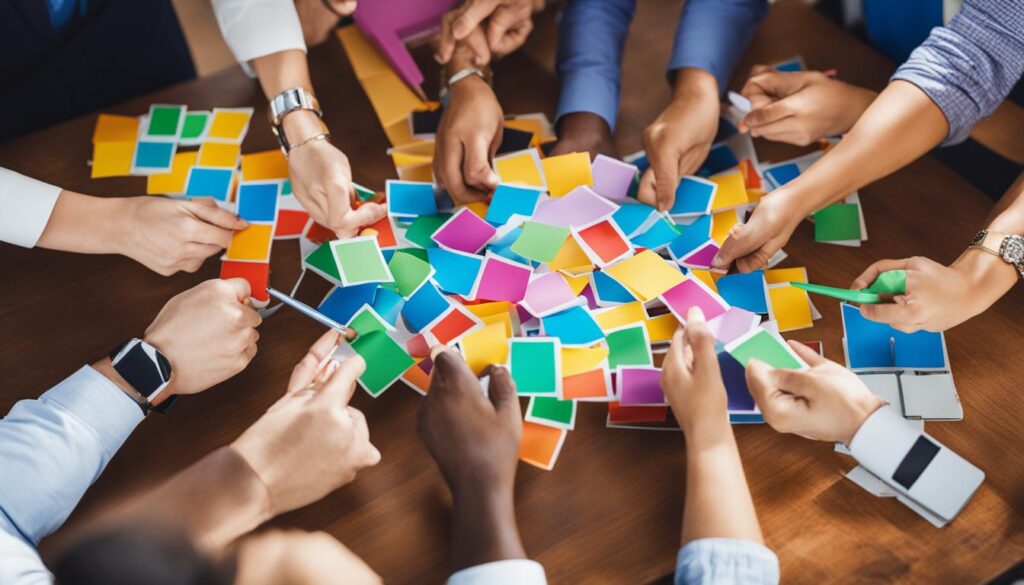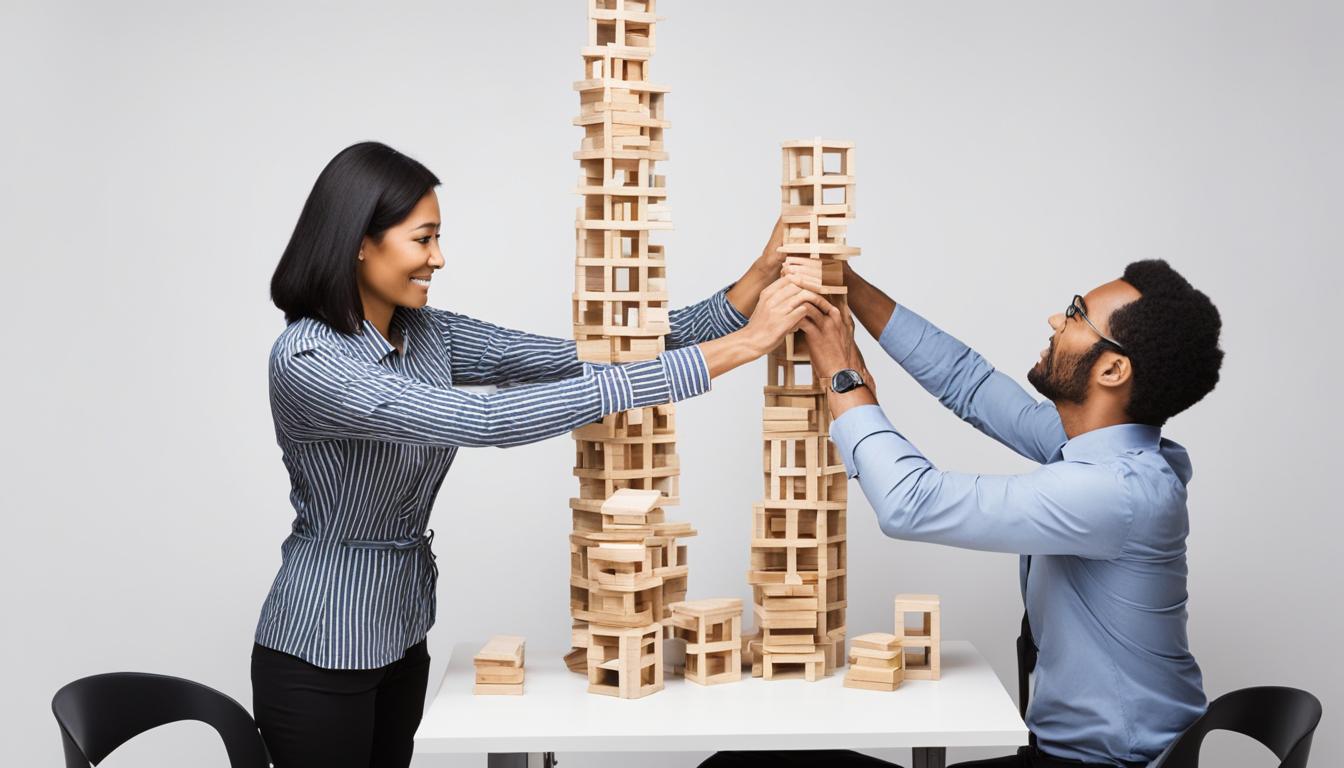Expand Your Connection: Engaging Relationship Building Activities For Stronger Connections
Relationship building activities are essential for creating strong connections and fostering teamwork within a team. These activities aim to strengthen the bonds between team members and enhance overall collaboration. Whether it’s through team building exercises, communication games, or problem-solving activities, engaging in relationship building activities can contribute to a more cohesive and productive team.
Team building activities provide an opportunity for team members to get to know each other better, build trust, and improve communication. By participating in these activities, team members can strengthen their relationships, develop a sense of camaraderie, and work together more effectively towards common goals.
In this article, we will explore various relationship building activities that can help strengthen connections within your team. From fun icebreakers to problem-solving challenges, we will provide ideas and suggestions to enhance teamwork, improve communication, and foster a positive team dynamic. So, let’s dive in and discover the exciting world of team building activities!
Key Takeaways:
- Engaging in relationship building activities strengthens the connections within a team.
- Team building activities enhance teamwork and collaboration.
- Communication exercises improve the overall dynamics of a team.
- Problem-solving games develop critical thinking skills and promote teamwork.
- Building trust through team bonding activities is crucial for a strong team.
Team Get to Know You Activities
Team get to know you activities serve as icebreakers, helping team members to connect and build relationships. These activities create a relaxed and comfortable atmosphere that encourages open communication and collaboration. By engaging in fun and interactive ways to get to know each other, teams can foster a sense of camaraderie and strengthen their working relationships.
One popular team get to know you activity is the “3 Question Mingle.” In this activity, team members pair up and take turns asking each other three questions. The questions can be about hobbies, interests, or personal experiences. This activity not only breaks the ice but also allows team members to initiate conversations and discover commonalities.
Another effective team get to know you activity is “9 Dimensions.” In this activity, team members share their best and worst moments in different aspects of their lives, such as work, personal relationships, or achievements. By sharing these experiences, team members can build a deeper understanding and empathy for one another, strengthening their connections.
Team get to know you activities are essential for creating a positive and cohesive team environment. These activities help team members build relationships, establish trust, and improve collaboration. By incorporating fun and engaging ways to get to know each other, teams can lay the foundation for successful teamwork and create a supportive work culture.
Funny Team Building Activities
Funny team building activities are a fantastic way to promote laughter, boost team morale, and create a more enjoyable work environment. These activities encourage team members to have fun, let loose, and strengthen their bond. By incorporating humor into team building, organizations can improve team morale and overall team dynamics.
One example of a funny team building activity is “Human Bingo.” In this activity, team members mingle and try to find someone who matches certain characteristics, such as “has traveled to more than five countries” or “has a pet dog.” It’s a hilarious icebreaker that encourages interaction and helps team members learn more about each other.
Another amusing activity is “Two Truths and a Lie.” In this game, team members take turns sharing two true statements and one false statement about themselves. The rest of the team then tries to guess which statement is the lie. It’s a lighthearted exercise that encourages creativity, guessing, and good-natured laughter.
Table: Funny Team Building Activities
| Activity | Description |
|---|---|
| Human Bingo | A mingling activity where team members try to find someone who matches specific characteristics. |
| Two Truths and a Lie | Team members take turns sharing two true statements and one false statement about themselves for the rest of the team to guess. |
Adding some laughter and fun to team building activities can have a positive impact on team morale and create a more cohesive and productive work environment. It’s important to remember that fostering a sense of fun and enjoyment within the team is equally essential for team bonding as other more serious activities.

Team Communication and Collaboration Activities
Effective communication and collaboration are vital for the success of any team. These skills enable team members to work together efficiently, share ideas, and achieve common goals. Engaging in team communication and collaboration activities can set time greatly enhance these essential skills and contribute to a more cohesive and productive team.
Active Listening Exercise
Active listening is a crucial aspect of effective communication. This activity focuses on honing this skill and promoting better understanding among team members.
- Divide the team into pairs.
- One person will share a personal story or experience while the other person actively listens.
- Afterward, the roles will switch, and the other person will share their story while the first person practices active listening.
- Encourage participants to ask questions and summarize what they heard to ensure comprehension.
This activity helps team members develop empathy, patience, and improved listening skills, ultimately leading to better communication and collaboration within the team.
Collaborative Problem-Solving
Collaboration is a key component of successful teamwork. This activity focuses on problem-solving as a team, requiring active participation and pooling of ideas.
Here’s how to conduct this activity:
- Select a problem or challenge that the team needs to solve.
- Encourage team members to brainstorm ideas and discuss potential solutions.
- Provide a structured framework for the problem-solving process, such as dividing the task into smaller steps or assigning roles to different team members.
- Facilitate open communication and encourage everyone to contribute and build upon each other’s ideas.
- Evaluate the effectiveness of the solutions proposed and consider the team’s collaboration during the process.
This activity fosters teamwork, critical thinking, and innovative problem-solving skills. It also encourages open communication and the idea that collaboration leads to more successful outcomes.

“Collaboration is key to success. By working together and leveraging each other’s strengths, teams can achieve great things.” – Unknown
Team communication and collaboration activities provide valuable opportunities for team members to develop effective communication skills, active listening abilities, and the overall teamwork necessary for achieving common goals. These activities timer cultivate an environment of trust, respect, and mutual understanding, leading to a more harmonious and productive team dynamics.
Team Problem Solving Activities
Problem-solving activities are an excellent way for teams to enhance their critical thinking skills and overcome challenges together. These activities require team members to think analytically, collaborate effectively, and generate innovative solutions. By engaging in team problem-solving activities, teams can strengthen their problem-solving abilities, promote teamwork, and achieve their goals more efficiently.
One example of a team problem-solving activity is the Escape Room Challenge. In this activity, teams work together to solve puzzles, decipher codes, and find hidden clues to escape from a locked room within a specified time frame. This activity not only tests critical thinking skills but also encourages effective communication and collaboration among team members as they work towards a common objective.
Another engaging team problem-solving activity is the Egg Drop Challenge. In this activity, teams are tasked with designing and building a contraption that will protect a raw egg from breaking when dropped from a height. This challenge prompts teams to think creatively, apply critical thinking, and collaborate closely to come up with a solution that ensures the egg’s safety. It emphasizes the importance of teamwork, problem-solving, and adaptability to overcome challenges successfully.
By participating in team problem-solving activities, teams can sharpen their critical thinking abilities and develop effective strategies to tackle complex issues. These activities foster collaboration, encourage creative thinking, and boost team morale. They create an environment where individuals can learn from one another, leverage their respective strengths, and overcome obstacles as a unified team.
| Benefits of Team Problem-Solving Activities |
|---|
| Strengthen critical thinking skills |
| Foster effective collaboration |
| Promote creativity and innovation |
| Enhance teamwork and communication |
| Bolster problem-solving abilities |
Team problem-solving activities not only provide an opportunity for teams to overcome challenges but also cultivate a supportive and cohesive team culture. These activities empower individuals to think outside the box, explore different perspectives, and work together to find solutions. By engaging in such activities, teams can build trust, improve their problem-solving skills, and achieve trivium remarkable results.

Testimonial:
“Participating in team problem-solving activities has been a game-changer for our team. We’ve witnessed a significant boost in our critical thinking skills, collaboration, and problem-solving abilities. These activities have not only helped us overcome challenges but also fostered a sense of togetherness and camaraderie.”
Team Bonding and Trust Building Activities
Building trust is crucial for a strong team. When team members trust each other, they can collaborate effectively, communicate openly, and navigate obstacles together. Team bonding and trust building activities are designed to strengthen relationships and develop trust among team members.
One example of a team bonding activity is the Blindfolded Obstacle Course. In this activity, one team member is blindfolded while the rest guide them through a course filled with various obstacles. The blindfolded teammate learns to trust their teammates’ instructions and relies on their guidance to navigate the challenges successfully. This activity not only builds trust but also enhances teamwork and communication skills.
Another trust-building activity is the Team Minefield. In this activity, team members are blindfolded and tasked with navigating through a “minefield” of objects while relying solely on verbal guidance from their teammates. The blindfolded team members must trust their teammates’ directions to avoid the obstacles and safely traverse the minefield. This activity fosters trust, communication, and teamwork, as team members work together to overcome challenges.
These team bonding and trust building activities not only strengthen relationships but also create a sense of unity and camaraderie within the team. When team members trust each other, they feel more comfortable taking risks, sharing ideas, and activities to try collaborating effectively. Trust becomes the foundation for a high-performing team that can navigate obstacles and achieve shared goals.
| Benefits of Team Bonding and Trust Building Activities | Examples of Team Bonding and Trust Building Activities |
|---|---|
|
|
Team Purpose and Alignment Activities
Team purpose and alignment activities are crucial for enabling teams to establish shared goals, improve collaboration, and align their vision. By engaging in these activities, team members develop a sense of purpose and are motivated to work collectively towards a common objective.
One example of a team purpose and alignment activity is a “Survivor” simulation. In this activity, teams are placed in a simulated survival situation where they must choose essential survival items and present their strategies for making it through challenging scenarios. This activity encourages teams to collaborate, make decisions together, and align their goals to successfully navigate the simulation.
Another effective team purpose and alignment activity is “Collaborative Storytelling.” In this activity, team members contribute to creating a story by taking turns adding elements to the narrative. This activity promotes collaboration, sparks creativity, and reinforces the importance of aligning individual contributions to a shared vision.
Through these purpose and alignment activities, teams develop a deeper understanding of their collective purpose, establish shared goals, and strengthen their collaboration. Such activities foster an environment of trust, unity, and effective communication, driving the team towards success.

Key Takeaways:
- Team purpose and alignment activities help establish shared goals and align the team’s vision.
- Activities like the “Survivor” simulation encourage collaboration and decision-making.
- “Collaborative Storytelling” promotes creativity and reinforces the importance of aligning individual contributions.
- Engaging in these activities fosters trust, unity, and effective communication within the team.
Checkout and Recap Activities for Your Team Building Workshop
As your team building workshop comes to a close, it’s important to incorporate checkout and recap activities that allow team members to reflect on their experiences and solidify the lessons learned. These activities provide an invaluable opportunity for teams to recap what they’ve learned, engage in meaningful discussions, and reinforce the key takeaways from the workshop.
One engaging checkout activity is to create a memory wall using sticky notes from the workshop activities. Each team member can write down their most memorable moments, insights, or aha moments on a sticky note and place it on the wall. This not only serves as a visual representation of everyone’s journey but also encourages reflection and discussion as team members browse through the wall.
Another effective recap activity is to facilitate a group discussion where team members share their reflections on the workshop. This can be done using a structured format, such as asking each team member to summarize their key takeaways or lessons learned. The discussion encourages active participation and allows team members to reinforce their understanding of the team building experience.
The Benefits of Checkout and Recap Activities
Implementing checkout and recap activities in your team building workshop has several advantages:
- Reflection: These activities provide a dedicated time for team members to reflect on their individual experiences and what they have gained from the workshop. Reflection helps solidify learning and encourages deeper understanding.
- Consolidation: By engaging in recap activities, team members can consolidate their knowledge and reinforce the concepts and skills they have acquired during the workshop.
- Discussion: Group discussions foster open communication and collaboration, allowing team members to share different perspectives, insights, and challenges faced during the workshop. These discussions promote a sense of camaraderie and encourage the application of newly acquired skills in the workplace.
Through checkout and recap activities, your team building workshop can leave a lasting impact on team members, ensuring that they not only remember the experience but also understand how to apply the learnings to their everyday work.
| Benefits of Checkout and Recap Activities |
|---|
| Reflection |
| Consolidation |
| Discussion |
These benefits ultimately contribute to enhanced team collaboration, improved communication, and a more positive work environment.

In the next section, we will explore team building workshop templates that can help you organize a comprehensive and effective session for your team.
Team Building Workshop Templates
When it comes to organizing and running effective team building sessions, having a structured framework is essential. This is where team building workshop templates come in. These templates provide facilitators with a complete agenda, including activity timings and instructions, to create a well-planned and engaging session for their teams. With a template, you can ensure that all necessary elements are included and that the workshop flows smoothly.
Also Read:- Spark Romance With A Couples Adventure Book
One platform that offers customizable team building workshop templates is SessionLab. SessionLab provides a user-friendly interface where you can design templates that cater to the specific needs of your team. Whether you’re conducting a virtual or in-person workshop, SessionLab allows you to organize activities, schedule breaks, and keep track of time, ensuring that your session is effective and efficient.
| Benefits of Team Building Workshop Templates |
|---|
| Ensures a structured and organized workshop |
| Provides clear instructions for activities and timings |
| Saves time in planning and preparation |
| Customizable to fit the needs of your team |
| Helps facilitate an engaging and effective session |
With a team building workshop template, you can eliminate the stress of creating an agenda from scratch and focus on delivering a memorable and impactful experience for your team. By leveraging the benefits of these templates, you can ensure that your team building sessions are well-organized, purposeful, and contribute to the growth and development of your team.
Conclusion
Team building activities play a vital role in strengthening relationships and enhancing collaboration, trust, and teamwork within a team. These activities bring team members closer together and create a positive and enjoyable work environment. By engaging in a variety of team building activities, organizations can foster strong relationships, improve job satisfaction, and promote a culture of trust and camaraderie.
Through team building activities, team members learn to communicate effectively, solve problems together, and align their actions with shared goals. These activities not only improve the dynamics of a team but also contribute to the overall success of the organization. When team members trust and collaborate with one another, they perform better, and the team as a whole becomes more efficient and productive.
Team building activities can range from icebreaker games to problem-solving challenges and trust-building exercises. The key is to provide opportunities for team members to interact, develop a deeper understanding of one another, and foster a sense of unity. By investing in team building activities, organizations can create a strong foundation for teamwork and set their teams up for success.
FAQs
Q: What are team get to know you activities?
A: Team get to know you activities are fun and interactive exercises that encourage team members to get to know each other better and build relationships. These activities create a relaxed and comfortable atmosphere for team members to initiate conversations and share personal experiences or preferences.
Q: How can funny team building activities benefit a team?
A: Funny team building activities are designed to promote laughter, boost team morale, and create a more enjoyable work environment. These activities encourage team members to have fun and let loose, which can enhance team bonding, promote positive relationships, and improve overall team dynamics.
Q: What are team communication and collaboration activities?
A: Team communication and collaboration activities focus on improving the communication and collaboration skills within a team. These activities emphasize the importance of clear and effective communication, active listening, and teamwork. They help team members understand each other’s perspectives, work together more efficiently, and build stronger relationships.
Q: How do team problem-solving activities help teams?
A: Team problem-solving activities are designed to develop critical thinking skills and improve the ability of team members to work together to overcome challenges. These activities require teams to think creatively, collaborate, and come up with innovative solutions. By engaging in problem-solving activities, teams can enhance their problem-solving skills, promote effective teamwork, and strengthen their relationships.
Q: What are team bonding and trust-building activities?
A: Team bonding and trust-building activities are designed to strengthen relationships and foster trust among team members. These activities often involve navigating obstacles or working together to achieve a common goal. The challenges faced during these activities help teams develop trust, enhance communication, and build stronger connections.
Q: What are team purpose and alignment activities?
Team purpose and alignment activities help teams clarify their shared goals, improve collaboration, and align their vision. These activities foster a sense of purpose and encourage team members to work together towards a common objective. By engaging in team purpose and alignment activities, teams can enhance their understanding of their purpose and enhance their overall performance.
Q: How can checkout and recap activities benefit a team building workshop?
A: Checkout and recap activities provide an opportunity for teams to reflect on their team building workshop experiences. These activities allow team members to recap what they’ve learned and discuss the key takeaways, which reinforces the learnings and emphasizes the importance of the team building experience. Reflection and discussion during checkout and recap activities help solidify the learnings and strengthen the team’s commitment to apply them.
Q: What are team building workshop templates?
A: Team building workshop templates provide a structured framework for organizing and running effective team building sessions. These templates include a complete agenda with activity timings and instructions, allowing facilitators to create a well-planned and engaging session. Using team building workshop templates saves time and ensures all necessary materials and activities are included in the workshop for a smooth and successful event.
Q: How do team building activities contribute to building stronger relationships?
A: Team building activities are essential for fostering strong relationships, improving collaboration, building trust, and enhancing teamwork. These activities bring team members closer together, create a positive and enjoyable work environment, and contribute to the overall success of a team. By engaging in a variety of team building activities, organizations can strengthen their teams, improve job satisfaction, and promote a culture of trust and camaraderie.
Q: What are relationship building activities?
A: Relationship building activities are creative ways to build and strengthen the relationships within a team or group. These activities can be team-building games, volunteer opportunities, or any fun ways to encourage colleagues to connect and bond.
Q: Why are relationship building activities important?
A: Relationship building activities are important because they allow team members to develop strong connections, which can positively impact teamwork, communication, and the overall company culture. These activities also provide a way for team members to share experiences and encourage colleagues to work together effectively.
Q: What are some examples of relationship building activities?
A: Some examples of relationship building activities include scavenger hunts, volunteer opportunities, coffee chats outside the office, team-building board games, or fun outdoor activities such as obstacle courses and team-building workshops. These activities aim to give each team member some takeaway and positive feedback to strengthen their connections.
Q: How can I encourage my team to participate in relationship-building activities?
A: To encourage your team to participate in relationship-building activities, consider incorporating fun and creative activities, setting a specific time for these activities during the workday, and providing opportunities for individuals to reflect on the experiences. Additionally, sharing the benefits of these activities, such as improved teamwork and communication, can also motivate team members to get involved.
Q: What are the benefits of team-building activities?
A: Team-building activities offer a way for the entire team to build positive relationships and connections, ultimately improving teamwork and enhancing communication. These activities also provide a fun and engaging way for team members to work together, solve problems, and develop a deeper understanding of one another.
Q: Can relationship building activities be conducted outside the office?
A: Yes, relationship building activities can be conducted outside the office. Activities such as scavenger hunts, coffee chats, outdoor obstacle courses, or volunteer opportunities can take place outside of the traditional work environment, providing a refreshing and engaging setting for team members to bond and interact.
Q: What are some popular relationship building activities?
A: Some popular relationship building activities include back-to-back communication exercises, team-building board games, blindfolded teamwork challenges, or volunteer opportunities where team members work together for a common cause. These activities are effective in promoting teamwork, communication, and a sense of unity within a group.
Q: How can relationship building activities strengthen team dynamics?
A: Relationship building activities can strengthen team dynamics by fostering trust, collaboration, and open communication among group members. By engaging in activities that encourage teamwork and problem-solving, team members can develop a deeper understanding of each other’s strengths and work more cohesively as a team.
Q: What are some ways to incorporate relationship building activities into the workplace?
A: Incorporating relationship building activities into the workplace can be done through activities such as coffee chats, board games, team-building workshops, or collaborative projects. Setting aside time for these activities and creatively instructing team members to engage in these activities allows employees to connect and bond within the work environment.
Q: How can relationship building activities benefit married couples or employees with families?
A: Relationship building activities can benefit married couples or employees with families by providing a fun and engaging way to interact with their colleagues and develop connections within the workplace. These activities also allow couples or individuals with families to share experiences and build lasting relationships with the rest of the group, ultimately enhancing their sense of belonging within the team or company.
